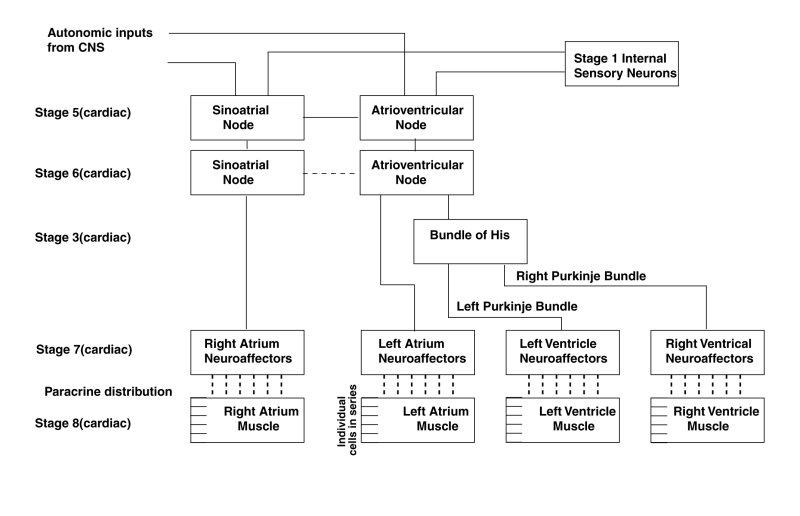INTRODUCTION
Last update:
Activa™: See Citation Page
The heart operates largely independent of the rest of the neural system of the organism. The neural subsystem of the heart includes all of the functional stages of the main neural system plus one additional stage unique to the heart. The following figure illustrates the system.

The cardiac stage 1 sensory components of the subsystem are largely unknown beyond the conceptual stage. It is obvious that the stage is able to sense a variety of characteristics regarding the operation of the heart, sense the status of the blood in the system, and provide that information to the central processor of cardiac stage 5. These signals provide the primary input for controlling the operation of the heart.
The extent of the cardiac stage 2 signal processing associated with the peripheral sensing and the extent of the cardiac stage 4 signal manipulation in support of the central processor is undefined but probably quite limited.
The system appears to use stage 3 signal projection techniques because of the size of the heart. Whenever a signal must be projected more than two millimeters, signal projection (rather than signal conduction/diffusion) techniques provide a faster and more energy efficient means of signaling. Many of the neurons within the Purkinkje fibers are of this stage 3 type.
The extent of cardiac stage 6 operation also appears to be quite limited, although there may be some expansion of individual instructions from cardiac stage 5 to support multiple areas of muscle activity.
Where distances exceed two millimeters, it can be assumed that stage 3 signal projection techniques are used in the efferent neural paths, just like in the afferent signal paths. This is the typical situation within the Purkinje fibers of the neural subsystem.
The cardiac stage 7 neuro-affectors actually stimulate the first cardiocytes of the contractile portions of the heart. By releasing a paracrine affector, they are able to stimulate multiple adjacent cardiocytes simultaneously.
A cardiac stage 8 has been defined to characterize the terminal cardiocytes which occur in parallel strings of individual cells. These cells operate as the primary contractile elements of the heart. Each cardiocyte simultaneously passes electrical stimulation to the next cardiocyte in their string via a synapse embedded in an intercalated disk.
It is noteworthy that nearly all of the cardiocytes of the heart incorporate some contractile capability so even the cardiocytes of the Purkinje bundles can change their length in conjunction with the rapidly contracting and relaxing muscle substrate over which they extend.
Return to the Heart home page
